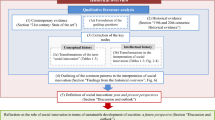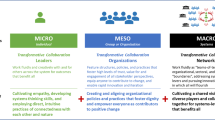Abstract
This paper discusses a way to create social innovation around 2040. With such innovation, social restrictions that are regarded as being inevitable in the current society can be eliminated. First, it is necessary to determine how to approach the innovation. Symbiotic technology is one of the promising technologies for achieving social innovation. It is the fusion of scientific technology and socio-technology. Its elemental technologies are classified into two categories: technologies for converging the real and cyber worlds and those for integrating hetero-systems. This paper describes examples of those technical categories and introduces the challenges of the first step toward social innovation.







Similar content being viewed by others
References
Allee V (2000) Knowledge networks and communities of practice. OD Practitioner 32(4)
Avizienis A, Laprie JC, Randell B (2001) Fundamental concepts of dependability. Technical report 01145, LAAS-CNRS, Toulouse, France
Axhausen KW (2006) Social factors in future travel: an assessment. Intell Transp Syst IEE Proc 153(2):156–166
Boccara N (2004) Modeling complex systems. Springer, New York
Boltze M (2003) A German example for a public private partnership in transport research. IATSS Res 27(1):19–32
Boltze M, Fellendorf M, Kuwahara M, Wolfermann A (2008) Traffic management—the key to more efficiency in road traffic. In: Proceedings of the international WS congress traffic transport 2030—visions, concepts, technologies, Feb 2008, pp 35–42
Camerer CF, Loewenstein G (2004) Behavioral economics: past, present, future. In: Advances in behavioral economics, chap 1. Princeton University Press, New York, pp 3–51
Carroll EA, Latulipe C, Fung R, Terry M (2009) Creativity factor evaluation: towards a standardized survey metric for creativity support. In: Proceedings of the 2009 conference on creativity and cognition, pp 127–136
Dorf RC (2001) Technology, humans and society: toward a sustainable world. Academic Press, London
Farkas I (ed) (2003) Artificial intelligence in agriculture. Comput Electron Agric 40(1–3) (special issue)
Figueira J, Greco S, Ehrgott M (eds) (2005) Multiple criteria decision analysis: state of the art surveys. Springer, New York
Fogg BJ (2003) Persuasive technology—using computers to change what we think and do. Morgan Kaufmann Publishers, San Francisco
Gilbert N, Troitzsch KG (2005) Simulation for the social scientist, 2nd edn. Open University Press, Buckingham
Granovetter M (2005) The impact of social structure on economic outcomes. J Econ Perspect 19(1):33–50
Grigori D, Casati D, Castellanos M, Dayal U, Sayal M, Shan MC (2004) Business process intelligence. Comput Ind 53(3):321–343
Hashimoto Y, Murase H, Morimoto T, Torii T (2001) Intelligent systems for agriculture in Japan. Control Syst Mag IEEE 21(5):71–85
Itaya S, Yoshinaga N, Davis P, Tanaka R, Konishi T, Doi S, Yamada K (2010) Common features of short-time dynamics of e-mail communication in work groups. The 7th Conference on the Application of social network analysis, Zurich, September 2010
Kahneman D (2003) Maps of bounded rationality: psychology for behavioral economics. Am Econ Rev 93(5):1449–1475
Khosla R, Chu MT, Doi S, Yamada S, Nishida T (2009) Knowledge flow networks and communities of practice in business process management. In: Handbook of research on complex dynamic process management: techniques for adaptability in turbulent environments. Business Science Reference, Hershey, pp 551–572
Levi-Strauss C (2006) Social structure. In: Anthropology in theory: issues in epistemology, chap 13. Blackwell, Malden, pp 136–146
Massoud Amin S (2002) Modeling and control of complex interactive networks. IEEE Control Syst Mag 22(1):22–27
Massoud Amin S, Wollenberg BF (2005) Toward a smart grid: power delivery for the 21st century. IEEE Power Energy Mag 3(5):34–41
Meadows DH, Meadows DL, Randers J, Behrens WW III (1972) The limits to growth. Universe Books, New York
Miwa K, Ishii N (2004) Cognitive approaches to creative activities. J Jpn Soc Artif Intell 19(2):194–204 (in Japanese)
Nau D, Wilkenfeld J (2008) Computational cultural dynamics. Intell Syst IEEE 23(4):18–19
Patel SN, Reynolds MS, Abowd GD (2008) Detecting human movement by differential air pressure sensing in HVAC system ductwork: an exploration in infrastructure mediated sensing. In: Proceedings of Pervasive 2008, Sydney, pp 1–18
Pearl J (2000) Causality: models, reasoning, and inference. Cambridge University Press, Cambridge
Perrin T, Kawai H, Kunieda K, Yamada K (2008) Global dynamics network construction from the web. In: Proceedings of the 2008 international workshop on information-explosion and next generation search
Robinson JB (1982) Energy backcasting: a proposed method of policy analysis. Energy Policy 10(4):337–344
Shime T, Kawai H, Bojduj B, Kunieda K, Yamada K (2008) Communication detection system considering areas, workshop on groupware and network service, information processing society, Japan, pp 115–120 (in Japanese)
Surowiecki J (2007) The wisdom of crowds: why the many are smarter than the few and how collective wisdom shapes business, economies, societies, and nations. Doubleday, New York
Tapscott D, Williams AD (2006) Wikinomics: how mass collaboration changes everything. Portfolio, USA
Tesfatson L, Judd KL (eds) (2006) Handbook of computational economics: agent-based computational economics, vol 2. North-Holland, Amsterdam
Toffler A (1980) The third wave. Bantam Books, ISBN 0-553-24698-4
van der Aalst WMP, ter Hofstede AHM, Weske M (2003) Business process management: a survey. International Conference on Business Process Management, vol 2678 of LNCS, pp 1–12. Springer-Verlag, Berlin
Vose D (2008) Risk analysis: a quantitative guide, 3rd edn. Wiley, Chichester
Yoshinaga N, Itaya S, Davis P, Tanaka R, Konishi T, Doi S, Yamada K (2010) Content propagation analysis of email communications. International workshop on computational social networks, Toronto, Aug–Sept 2010
Acknowledgments
The authors appreciate meticulous comments by Dr. Kunieda and Mr. Kawai.
Author information
Authors and Affiliations
Corresponding author
Rights and permissions
About this article
Cite this article
Doi, S., Yamada, K. Symbiotic technology for creating social innovation 30 years in the future. AI & Soc 26, 197–204 (2011). https://doi.org/10.1007/s00146-010-0308-0
Received:
Accepted:
Published:
Issue Date:
DOI: https://doi.org/10.1007/s00146-010-0308-0




